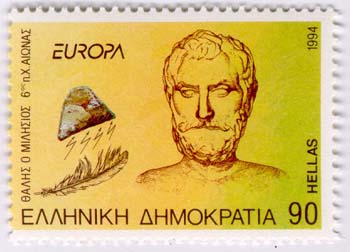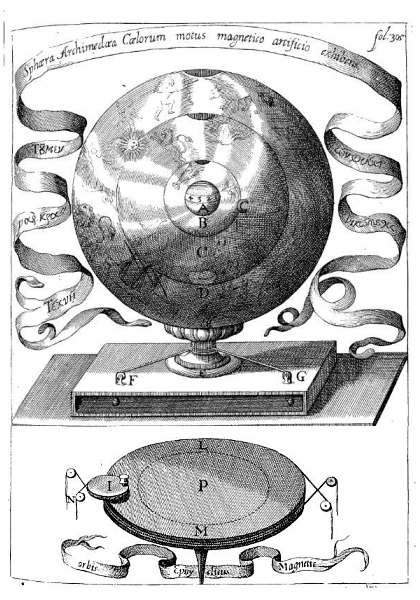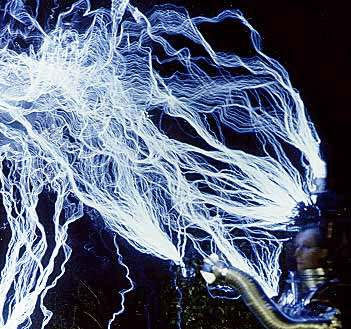.
Antikes Griechenland: Ideen über Elektrizität und Magnetismus

Thales in a stamp together with the amber or ilektron that is able to attract other objects if charged
The words electricity and magnetism are Greek words since the Greeks were among the first who observed electromagnetic effects. Amber was used in antiquity for decoration, often with alloys of gold and silver, and was called electron. William Gilbert, physician to Queen Elizabeth I, used the word electron to produce the word "electricity".
Magnetic iron ore was found near Magnesia on the Maeander in Asia Minor. According to Lucretius (98-55 BC), the term magnet is derived from Magnesia.
The ancient Greeks were thinkers and philosophers, but they did not perform experiments to quantify electric and magnetic phenomena. They observed thunderstorms, lightning, and St. Elmo's fire. They also observed magnetic attraction and repulsion, but their knowledge of science and technology could not explain these phenomena, nor did they investigate them systematically or put them to practical use.
The magnetic compass is one of the first scientific instruments to have been used extensively. Its origins are not well documented, but legends about its early use abound. The Chinese, Arabs, Greeks, and other groups have all been credited as the originators.
It is more likely that the Chinese began to use lodestones to indicate south and north in the early centuries of the Christian era. Ancient documents describe pieces of lodestone, or magnetite, several inches in diameter, with their bottoms rounded and a little tail on top to indicate one of the poles. They called it a spoon, and when placed on a hard, smooth surface and rocked gently, the tail pointed south. Other ancient Chinese manuscripts describe indicators made of a magnetized steel needle floated on a chip of wood or on a reed in a bowl of water, or a needle suspended on a single filament of silk. Since then, compass designers have made many improvements, and much has been learned about terrestrial magnetism. Even today, however, we still have much to learn about magnetism and the dynamics of the earth 's magnetic field.
Thales of Miletus (Θαλής ο Μιλήσιος)(from 640-610 to c. 548-545 ) BC, son of Examyas of Miletus and Cleobuline, was chief oft he "Seven Wise Men" of his time and gained much acclaim by predicting a total eclipse of the sun in May 585 BC. Much of his fame came from introducing geometry from Egypt into Greece, before the time of Euclid, making substantial contributions and communicating the beginnings of many propositions to his successors.
Thales is credited with discovering that amber rubbed with wool or fur attracts light bodies such as pieces of dry leaves or bits of straw, and observing that lodestone attracts iron and other lodestones. None of Thales's manuscripts is known to have survived to modem times. Everything we know about him comes from accounts written by others.
Thales except some first observations of electrical effects also showed the influence of a Magnet has to a piece of iron, showing that everything has some “soul”, “is filled with Gods” according to Aristotle's De Anima (On the Soul):
And Thales, according to what is related of him, seems to have regarded the soul as something endowed with the power of motion, if indeed he said that the loadstone has a soul because it moves iron.
On the Soul, i. 2; 405 a 19.
Socrates (470-399 BC) wrote of lodestone "that stone not only attracts iron rings, but imparts to them a similar power of attracting other rings; and sometimes you may see many pieces of iron and rings suspended from one another to form quite a long chain; and all of them derive their power of suspension from the original stone".
About 900 BC we have the story of
... a Cretan shepherd by the name of Magnés, whilst tending sheep on the slopes of Mount Ida, found that his iron tipped crook and the nails of his boots were attracted to the ground. To find the source of the attraction he dug up the ground to find stones that we now refer to as lodestones (also spelled loadstone; lode means to lead or to attract) which contain magnetite, a natural magnetic material Fe3O4. From a lecture of David Harrison.
and also
...Archimedes is reputed to have used powerful lodestones to pull the nails out of enemy ships thus sinking them.
I suppose that even the strongest magnets today cannot do this (except maybe using strong magnetic fields produced by explosive devices???) and therefore the story is very probably wrong.. or did Archimedes use some unknown method???

Athanasius Kircher's reconstruction of the sphere of Archimedes, imitating the motion of the planets with the aid of magnets. From Magnes, sive de Arte Magnetica (1643 ed.) p. 305
The first reference to the pyroelectric effect is made by Theophrastus in 314 BC, who noted that tourmaline becomes charged when heated. He wrote that lyngourion (most likely the mineral tourmaline) had the property of attracting straws and bits of wood.
Another story is that of Ptolemy II Philadelphus who had a temple at Alexandria made from magnetite and according to some tried to suspend a statue of himself in mid-air. Today this is not complicated (at least for small objects), see: http://www.physics.lsa.umich.edu/demolab/demo.asp?id=818. For objects like a heavy statue even today this would be difficult I assume.
From http://www.tcd.ie/Physics/Schools/what/materials/magnetism/two.html I have the following information:
Only recently has it been understood that it is possible to levitate a permanent magnet with the help of diamagnetic material. On the right we see levitation of a Ni-Fe-B magnet in the field of another magnet, stabilised using the feeble diamagnetism of two human fingers. (visit the website to see the image) Diamagnetic objects like drops of water or frogs can be levitated when the product of magnetic field and field gradient exceeds about 14 tesla2/cm.
Electro Therapy?
The Greeks and Romans were known to combat the pain of gout by standing patients upon electrical eels until their feet became numb BAGHDAD BATTERIES
Pyroelectricity:
British Ceramic Transactions 1 April 2004, vol. 103, no. 2, pp. 65-70(6)
Lang S.B., A 2400 year history of pyroelectricity: from Ancient Greece to exploration of the solar system
Abstract:
Pyroelectricity was probably first observed by the Greeks more than 24 centuries ago. The philosopher Theophrastus wrote that lyngourion (most likely the mineral tourmaline) had the property of attracting straws and bits of wood. For two millennia the peculiar properties of tourmaline were more a part of mythology than of science. In the eighteenth century pyroelectric studies made a major contribution to the development of our understanding of electrostatics. In the nineteenth, research on pyroelectricity added to our knowledge of mineralogy, thermodynamics and crystal physics. Pyroelectricity gave birth to piezoelectricity in 1880, and to ferroelectricity in 1920. The field of pyroelectricity flourished in the twentieth century with many applications, particularly in inf rared detection and thermal imaging. Pyroelectric sensors have been carried on many space missions and have contributed significantly to our astronomical knowledge.

From Thales static electricity to the “electric” Show of Dr. Megavolt
References, LINKS
| Ancient Greece
Science, Technology , Medicine , Warfare, , Biographies , Life , Cities/Places/Maps , Arts , Literature , Philosophy ,Olympics, Mythology , History , Images Medieval Greece / Byzantine Empire Science, Technology, Arts, , Warfare , Literature, Biographies, Icons, History Modern Greece Cities, Islands, Regions, Fauna/Flora ,Biographies , History , Warfare, Science/Technology, Literature, Music , Arts , Film/Actors , Sport , Fashion --- |

